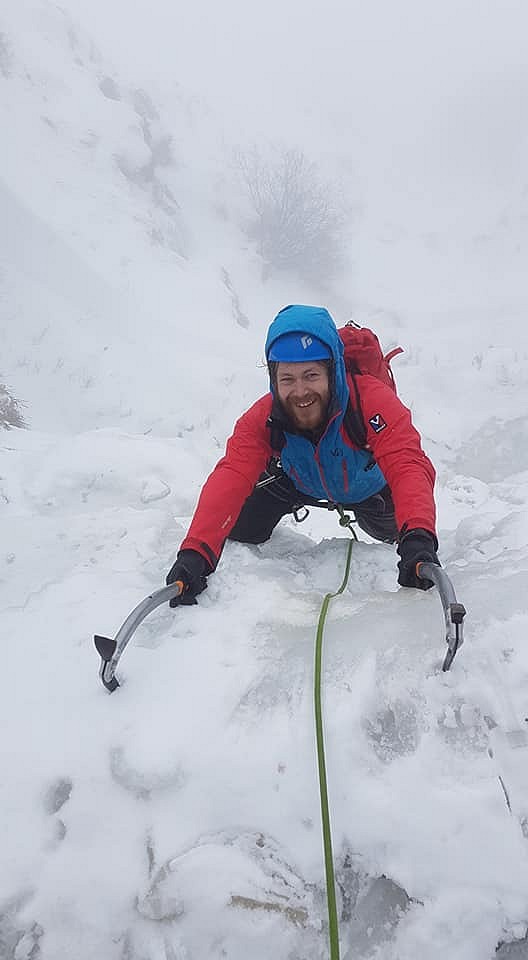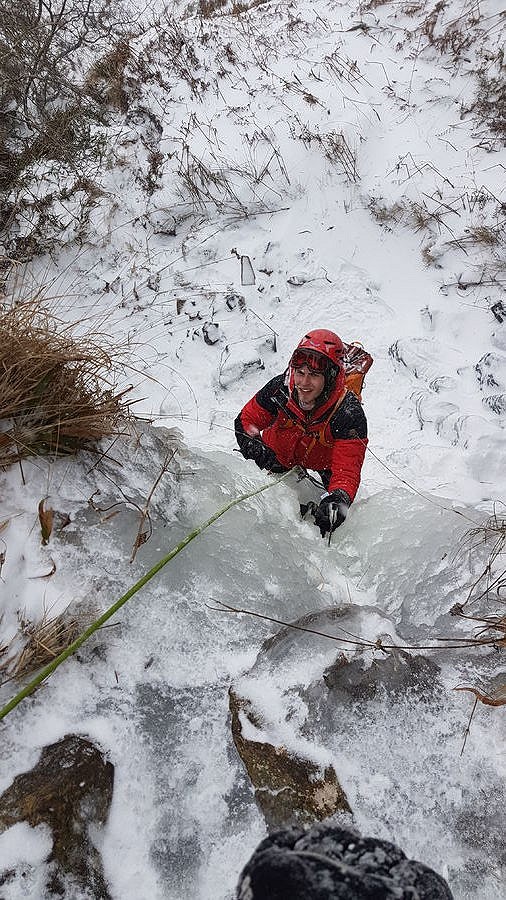
David Kilner shares some local knowledge for South Walian Winter climbing, inspired by Toby Archer's popular 'Chasing the Very Bloody Ephemeral' article on winter climbing in England and North Wales...
I sit fixated, ignoring worldly responsibilities, absorbing every report, comment and picture streaming out of the early Scottish winter that is flourishing. The Northern corries seem alive with activity and opportunity, I'm gazing at pictures of climbs I know but may never go on – Honeypot, The Messenger – The Seam – just give me a chance, my armchair bound body says. My brain reminds me of steep and insecure leads on the very few IVs I've done…hmm maybe, just maybe, this winter. Just give me a chance. Give me perfect conditions and I will be fine.
I was delighted to see Toby Archer's UKC article 'Chasing the Bloody Ephemeral' before Christmas… more ammunition to the daydreaming mind.
All UK winter guidebooks made their way to the floor of the living room and then to the bedside table – highest crags, quickest to come in to condition, snowed up rock? Ameniable routes? Soloable routes? Length of approaches – I must be ready – I reach for my folder of scraps – South Wales winter climbing wikis, lines drawn on pictures, I make mental notes of Facebook discussions had with those in South Wales who first climbed these routes. If and when it gets cold this far south – I will be ready.
I drift to the more ephemeral ice falls of North Wales and the Lakes. Places I might be able to make a pass at before the February pilgrimage to Scotland, but not forgetting last year and what took place on my very doorstep.
One statement stood out from Toby's article while describing the geographical whos and wheres:
"Geordies are virtually in Scotland anyway, while Bristolians and those further south should probably just sell their ice tools."
It nagged at me, but I couldn't let it go…we'd seen so much winter in South Wales last year that something needed to be said – people need to know what South Wales has to offer and maybe talking about it will make it all come back and the cold settle in…I guess if winter was on my doorstep right now I wouldn't have considered even writing this. How an idle mind can be turned.
Not after last year at least anyway. Desperate to climb some of South Wales' finer winter climbs I began my search on 8th January with the first snow on its highest peak, Pen y Fan (886m). With 20+ winter routes to its name including numerous easy gullies and ribs, a fine central gully and headwall with routes up to tech 6 (I've only ever stared at them) it's a gem to behold (this far south) in its winter attire.
There are a number of other venues that may offer a small amount of mixed climbing but as South Wales' highest bit of rock, Pen y Fan is the most reliable place to go when the weather takes a turn...but if you do live in the south then you already know that. A fantastic place to be in all conditions and just an hour and half approach to the base of the climbs means you can take in sunrise/sunset and ground conditions on your way in. Good training for more winter climbing either way!
Cold Snap
Pen y Fan NE face (I-IV) is the highest and most reliable venue. Most routes are entirely reliant on frozen turf, so a period of cold northerly winds before any dump of snow is vital.
Central gully (III) runs clean up the centre of the face, trending off left towards the top. A direct finish (IV) to central gully as well as the impressive lines of Pat's Right facing Corner (IV) (yes, Mr Littlejohn gave us his attention), Alligan (IV) and Steeple (IV) all go through this quite intimidating terrain.
There are a huge number of easy gullies across the expanse of the face and even some new lines being put up now. Paul Tucker adding Celebration Day (III/IV) up one of the mid height buttresses.
Don't forget the turf, the face is a sloppy mess of loose blocks and red clay in the summer, remember this when contemplating climbing in marginal conditions.
The First and The Last
Torpantau Icefalls 200m (III 3) - tucked snuggly away within the central Beacons horseshoe, this is the highest (600m) and (possibly the) fastest forming of the numerous waterfalls in the area. Usually with a good couple of short pitches either side of the main fall this makes for a great day/morning out! The nearby and lower Blyn y Gwyn falls would complete the day but need a good long chilling to be in.
On my last visit to Torpantau a midday deadline due to rising freezing levels ensured an early start – 5am departure to be on the safe side!
An impassable final 5km of road on the approach meant putting our heads down, crossing our fingers and hoping we'd arrive in time. The falls sit in a secluded valley on the opposite side to the memorial for an old WW2 bomber that crashed here on its return from a bombing raid during the Blitz.

The falls are up to 15m wide in their central pitch. Offering 3 good pitches of climbing and some shorter steps at either end, Torpantau is a view to behold for the winter-starved South Walian. A few variations are possible on the wider pitches making for a great day out. We abbed back down the main pitch to lead it again before the Beast retreated for the last time in 2018.
Colder Snap
A great first for my South Wales winter career was climbing the main falls at Craig Cwm Du. Set just off the A470 with a simple approach, this north-facing cwm has a base at approximately 500m, is quick to form and holds its ice long after a thaw.
Checking ice conditions on the nearby Craig y Fro - also known as RAC corner - for some roadside ice climbing from the Storey Arms, things were looking very promising for a fully formed Rhaeadr Cwm Du.
Walking in through deep drifts and ever decreasing visibility we don't see the line until we are almost underneath it.
A slither of ice runs upwards towards the top of the cliff filling out the falls' main course. It's the first time I've laid eyes on the set of falls while fully frozen. Thoughts of the storm due in later this evening are pushed to the back of my mind. There is time to climb.

The first pitches are dispatched quickly, Rhaeadr Cwm Du gives 4/5 pitches of beautiful ice at an amenable III 3. A steep, almost vertical middle pitch gives good value and makes this a fantastic venue for the southerly enthusiast!
A stunning fall that you can't quite believe exists in South Wales. For all those winter wonderers, with a week of cold weather and snowfall behind us (down here at least) it's time to get planning and crossing fingers for more cold weather in the next month or two.
During last year's Beast, further west Joe's Waterfall is tackled under an incredible array of chandeliers and even aired on ITV. The cold snap is too short lived and the demands of work too long to get over there for our own go. But there will be another opportunity!

Craig y Llyn, and Cwm Lluest (Virgin Falls) both have brilliant lines waiting for more sustained cold weather!
The reality is as follows: if you want to get out and winter climb in the south, then the age-old adage of 'If you don't go then how will you know?' remains. Watching weather forecasts and planning for a long walk all go a long way to help when conditions are finally in. But getting out early, enjoying the sunrises, the uncertainty and just being out in the mountains will all be rewarded (one day anyway!)
The last couple of years from my South Wales base I've chased and chased the ephemeral. 4am starts get you to Snowdonia - I made three day trips last year! Only once dragging a friend with me…'This winter mountaineering is fun!' I told him as I spent over an hour on an aborted attempt at the opening icefalls of Moonlighting (V 5) at Craig Lloer in the Ogwen Valley, before settling for a jaunt up Broad Gully and topping out in a storm. The drive home was not quite so full of optimism as at the start.
Getting out on the hills on a wintry day is hugely rewarding and enjoyable in its own right. There are still at least 80 days of winter left for South Wales. Let's not cross our fingers, let's just get out there and enjoy the adventure.





















Comments
Nice piece, thanks. I was on Pen-Y-Fan/Corn Du on 2nd Feb (walking), and the effect of a proper cold week before/during the snowfall was obvious - no snow scooting off wet turf underfoot as you descend; almost alpine-like powder snow where it hadn't melted/re-frozen. It was beautiful. As you say, when you live in the SW you just have to get out when you can, you may only get a couple of chances each winter. By the following Monday, after a huge rainstorm, the Beacons were green again..
Good article.
https://www.facebook.com/groups/SouthWalesWinterClimbing/